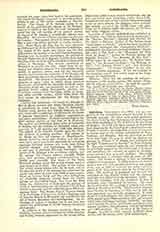

Barcelona, UNIVERSITY OF.—This was an out-growth of the ecclesiastical schools founded in the eleventh century. To these were added gradually the chairs held by the Dominicans in their convent and those established in the Academia by the Kings of Aragon. In 1430, the town council of Barcelona took measures for the founding of a Studium Generale in order to prevent the migration of their young men to Lerida and to the foreign universities of Paris, Toulouse, and Bologna. But the university as such dates from 1450, the year in which its charter was granted by Alfonso V of Aragon and confirmed by the Bull “Constitutus in Speculo” of Pope Nicholas V. The pope conferred upon the new university all the privileges enjoyed by the University of Toulouse and authorized the erection of chairs in theology, canon and civil law, arts, and medicine. The young institution had to struggle with all sorts of difficulties. For nearly a century it had no buildings adapted to its purposes. In 1544, however, it entered upon a new era, with suitable structures and equipment, and in 1567 it received the richly endowed priory of St. Ann, formerly held by the Order of St. John. The teaching of grammar and rhetoric was entrusted to the Jesuits (1576) and the diocesan seminary was affiliated to the university (1568). In 1714 the Faculties, with the exception of that of medicine, were transferred to Cervera. By royal decree of Charles III, a college of surgery was established at Barcelona in 1764. The Faculties returned from Cervera to Barcelona in 1823, and in 1837 the new university was formally inaugurated. It withstood the disturbances that occurred in 1840 and 1856, passed under State control in 1857, and was provided with additional buildings (1863-73). At present it has five Faculties: philosophy and letters, law, science, medicine, and pharmacy, with 56 instructors and 1,900 students. The Archives of the Crown of Aragon, founded in 13:6, contain 3,759,314 documents, and the library about 2,000 manuscripts.
E. A. PACE

